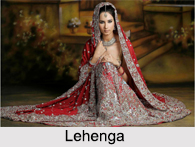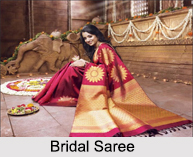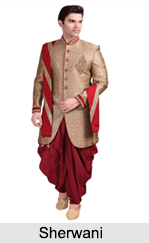 The Indian wedding dresses are myriad in colour, style and fashion in the different parts of the nation. It differs from region to region as per the traditions of the different communities. The typical Indian wedding dresses range from Salwar-Kameez-Dupatta, Lehenga-Choli to Sarees. Like for instance, the traditional bridal dress in northern India is salwaar kameez, whereas in western region it is lehenga choli and in eastern and southern parts, it is the colourful, lovely sarees in diverse styles. The Indian wedding dresses are basically bright coloured mostly red or a variant of red. Colours like white and black are avoided as they are synonymous with funeral and mourning. Whereas, red is known as the traditional colour of Indian wedding dresses and it is also believed that this colour brings good luck and happiness in the life of newly married couple.
The Indian wedding dresses are myriad in colour, style and fashion in the different parts of the nation. It differs from region to region as per the traditions of the different communities. The typical Indian wedding dresses range from Salwar-Kameez-Dupatta, Lehenga-Choli to Sarees. Like for instance, the traditional bridal dress in northern India is salwaar kameez, whereas in western region it is lehenga choli and in eastern and southern parts, it is the colourful, lovely sarees in diverse styles. The Indian wedding dresses are basically bright coloured mostly red or a variant of red. Colours like white and black are avoided as they are synonymous with funeral and mourning. Whereas, red is known as the traditional colour of Indian wedding dresses and it is also believed that this colour brings good luck and happiness in the life of newly married couple.
The Indian wedding dresses are quite different from the western style of wedding attire. The Indian wedding dresses are generally bright in colours preferably red, orange, blue, rust, pink, peach, magenta, and maroon or green. One of the main features of traditional Indian wedding dresses is that they are embellished with gorgeous needlework. However, nowadays the Indian bridal dresses have come in some really beautiful varieties and in custom made designs and cuts. Gorgeous and colourful are the two words that could be ascribed to an Indian wedding dress. Indian brides sparkle and shine on her special day and this expectation is totally credited to the bright outfit, excellent make up, perfect accessories, unique jewellery and so on. Indian wedding traditional dresses are generally brightly coloured and wonderfully embellished ensembles. Thus, beautiful Indian wedding dresses can make the bride look beautiful if perfectly suited.
 Types of Indian Wedding Dresses for Women
Types of Indian Wedding Dresses for Women
The Indian wedding dresses reflect the incredible amount of religious and cultural varieties of the Indian subcontinent. Thus, the exact style of wedding dresses in India varies from one region to another. Some of the most common styles of Indian wedding dresses are sarees, lehenga choli and salwar kameez.
A saree is a piece of cloth wrapped around the body in a very intricate pattern. Today, women prefer to wear bridal sarees available in diverse styles. On the other hand, lehenga-choli typically comprises a long skirt and a short blouse. A lengthy scarf with rich embellishments is called a dupatta completes the look of a lehenga-choli. A salwar kameez is a long tunic kind of dress worn over pants, along with a dupatta. All these traditional wedding dresses are made of bright colours with heavy embellishments and embroideries. Red sarees are the traditional garment choice for brides in Indian culture. The saree fabric is also traditionally in silk. Over time, colour options and fabric choices for Indian brides have expanded. Nowadays, fabrics like crepe, georgette, and satin are used, and colours have been expanded to include gold, pink, orange, maroon, brown, and yellow as well. The most common fabrics used in traditional Indian wedding dresses are silk, chiffon, satin, and other fabrics those have shine and reflect light. In addition to the wedding dress, there are some elements of wedding wear that are crucial to and adorn the beauty of the wedding attire an Indian bride. These accessories include necklaces, rings, earrings, bracelets, etc. This type of immense ornamentation is a traditional part of the wedding collection. Although trendier designs are now coming into fashion, the traditional pieces have not lost its colour.
 Types of Indian Wedding Dresses for Men
Types of Indian Wedding Dresses for Men
Many communities of South, West, and Eastern India still adhere to the traditional costumes, i.e. Dhoti, or sometimes Lungi, and Mundu by some communities of the South. Kurta or a shirt may be worn or sometimes just an Angavastram may be used to cover the chest. On the other hand, in the Northern parts, the bridegroom usually wears a Sherwani, Jodhpuri suit, or a western suit. The groom"s face is covered with a veiled curtain of flowers which is called Sehra in the North, which is not the custom elsewhere. It is also customary to wear a Taqiyah all through the ceremony in Muslim marriages. Most men also prefer to wear a Kurta. The exquisite shirts, coats, and jackets are designed with extra care and touch to bring out the magnanimity out of the bridegroom on the marriage day. Precious embellishments are studded into the collars and the cuffs of the bridegroom"s dress. Available both in simple cotton and splendid, royal raw silk, these Kurta Pyjamas are preferred mostly by the bridegrooms.

















